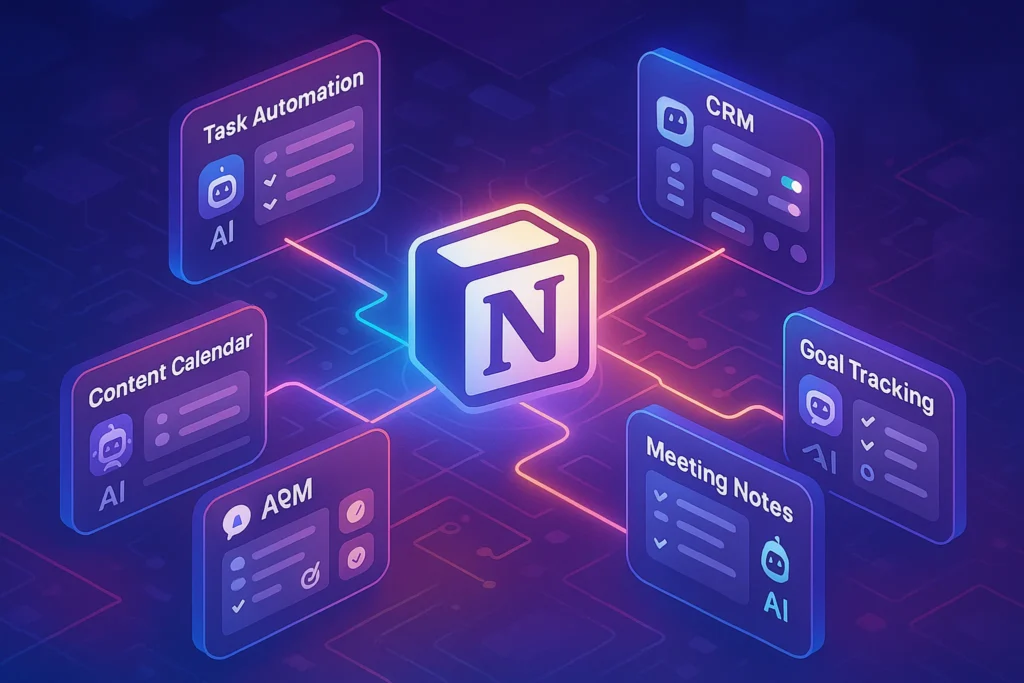⏰ The Problem of Chaos in Team Scheduling
Every team knows the feeling: endless back-and-forth messages trying to find a time that works, double-booked meetings, forgotten deadlines, and people showing up late because the invite didn’t hit their inbox. Chaos in scheduling drains productivity faster than almost any other operational bottleneck. In fact, research from Atlassian shows that workers waste nearly 31 hours per month in unproductive meetings, and much of that time is caused by poor scheduling practices.
This is where team calendar apps make a difference. Instead of scattered Google Docs, Slack threads, and email chains, a shared calendar becomes the single source of truth. Everyone sees the same schedule, knows who’s responsible for what, and gets real-time updates if anything changes. The result is fewer headaches and more time spent on actual work.
💡 Nerd Tip: If scheduling chaos is eating up your week, a team calendar isn’t just a tool—it’s an insurance policy for focus.
Instead of scattered Google Docs, Slack threads, and email chains, a shared calendar becomes the single source of truth. That’s why Best Smart Calendar Apps for Productivity have become must-haves for teams in 2025.
📌 Why Team Calendar Apps Are Essential
It’s tempting to think a personal calendar is enough. After all, most professionals already use Google Calendar or Outlook for their day-to-day tasks. But a team calendar serves a completely different purpose. Instead of siloed schedules, it offers visibility and coordination across multiple people, departments, and even time zones.
Think of the difference between managing your own gym routine versus coaching a sports team. Personal calendars help you stay fit; team calendars ensure the whole squad shows up at the right stadium, at the right time, with the right equipment.
The need is even greater for distributed teams. Remote collaboration has grown by more than 44% since 2020, and hybrid offices are here to stay. Without a shared system, projects stall because “I thought you were handling that deadline” becomes a common refrain. With a team calendar, tasks, meetings, and milestones live in one place—clear, visible, and accountable.
🔍 Key Features to Look For in a Team Calendar
Not all team calendars are built equal. Choosing the right one means balancing functionality with usability so that adoption doesn’t become another battle.
Shared views are the foundation. Teams need to see who’s doing what without drowning in clutter. Daily, weekly, and monthly views allow for both granular detail and big-picture planning. Role-based permissions matter just as much. Leaders should be able to edit, while participants may only need viewing access. This avoids accidental changes that throw off an entire sprint.
Time zone handling is crucial for global teams. A 10 a.m. meeting in New York is not the same as 10 a.m. in Berlin, and a good team calendar automatically adjusts for every participant. Integrations are the glue. Tools like Slack, Zoom, and project management platforms need to connect seamlessly. Imagine booking a meeting in your calendar that instantly generates a Zoom link and sends reminders on Slack—that’s efficiency without friction.
💡 Nerd Tip: If an app makes you manually handle time zones, skip it. The right calendar saves more arguments than any manager ever could.
🌟 Best Team Calendar Apps in 2025
By 2025, the market for calendar tools has exploded, blending AI assistance with robust integrations. Here are the standouts:
Google Calendar for Teams remains the default for many organizations. Its biggest strengths are simplicity, cross-device sync, and deep integration with Google Workspace. The downside? Limited project-focused features unless paired with add-ons.
Outlook Calendar continues to dominate in enterprise settings, especially where Microsoft 365 is the backbone. Its advanced scheduling assistant is excellent for large teams, though its interface can feel outdated compared to newer players.
Calendly Teams has grown beyond individual scheduling links into a full-fledged team solution. It’s especially useful for client-facing teams, allowing prospects to pick slots without endless email threads. The drawback is pricing for larger teams, which can climb quickly.
Motion has made waves by layering AI onto calendars. Instead of just displaying meetings, it automatically re-prioritizes tasks when unexpected events pop up. Teams using Motion report up to 15% gains in productivity, though its learning curve can intimidate first-time users.
Teams using Motion report up to 15% gains in productivity, though its learning curve can intimidate first-time users. This aligns with trends we’ve explored in How AI Can Automate Your To-Do List and Calendar, where AI takes scheduling from reactive to predictive.
ClickUp Calendar isn’t just a calendar—it’s part of a larger project management suite. Its calendar integrates tasks, deadlines, and meetings in one unified view, making it ideal for marketing or content teams. The trade-off is that it can feel heavy for teams who only need a simple calendar solution.
Each of these tools brings different strengths, and the best choice depends on whether you value simplicity, AI-driven optimization, or deep project management integration.
Its calendar integrates tasks, deadlines, and meetings in one unified view, making it ideal for marketing or content teams. It pairs well with concepts from Monday Content Planning: AI Calendar, where calendars act as campaign command centers.
💼 Use Cases That Prove the Value
For remote teams, calendars are lifelines. With members spread across continents, a shared system prevents overlapping shifts and misaligned deadlines. A developer in India knows when the designer in California is available, eliminating overnight email delays.
Hybrid offices benefit in different ways. Coordinating “in-office” versus “remote” days becomes effortless when everyone logs their schedules into a shared view. This prevents overcrowded Tuesdays and empty Fridays.
Content and marketing teams thrive with calendars that integrate campaign milestones. Imagine tracking blog deadlines, video shoots, and launch dates all in one visual dashboard. It’s easier to spot bottlenecks and redistribute workloads before deadlines slip.
Agencies juggling multiple clients often find chaos at its peak. A team calendar ensures that one client’s campaign review doesn’t collide with another’s onboarding call. Some agencies even color-code clients, allowing instant visibility without confusion.
A developer in India knows when the designer in California is available, eliminating overnight email delays. This kind of alignment becomes even stronger when combined with Best AI Tools for Remote Team Collaboration, which extend calendars into a full remote toolkit.
Even the best tool can’t fix bad practices. To make a team calendar effective, ownership must be clear. Someone needs to set and maintain events, whether it’s a project manager or rotating team leads. Without ownership, calendars become outdated graveyards of forgotten events.
Color-coding and tagging bring order. Assigning distinct colors for departments, projects, or clients makes it easy to scan for what matters. Tags like “urgent,” “review,” or “external” add another layer of clarity, especially when multiple priorities compete for attention.
Automated reminders are the silent heroes. Notifications sent 10 minutes before a meeting or a day before a deadline reduce no-shows and missed tasks. According to Microsoft’s internal data, reminders decrease meeting absenteeism by nearly 25%.
💡 Nerd Tip: Don’t just use your calendar as storage—use it as a system. Automation and structure turn a static tool into a dynamic asset.
Automated reminders are the silent heroes. Notifications sent 10 minutes before a meeting or a day before a deadline reduce no-shows and missed tasks. Paired with Best Workflow Automation Tools for Solopreneurs & Remote Teams, these features ensure that nothing slips through the cracks.
📊 Case Study: From Chaos to Clarity
Consider a marketing agency with 25 employees spread across three countries. Before adopting a shared calendar, their weekly meetings were plagued with late starts, missing members, and double-booked client calls. Productivity suffered, and deadlines were consistently missed.
They implemented ClickUp Calendar with role-based permissions and color-coded tags. Within a month, scheduling conflicts dropped by 40%. The team also integrated Slack notifications for real-time updates. The agency director later reported: “We stopped losing clients because of missed reviews. The calendar became our silent project manager.”
This shift not only saved time but also improved morale. When everyone knew where to look for updates, accountability and focus skyrocketed.
⚡ Simplify Your Team’s Scheduling Today
Test-drive powerful calendar apps like Motion or ClickUp Calendar to reduce chaos, align teams, and reclaim hours lost to poor scheduling.
📈 ROI and Productivity Data
One of the most convincing reasons to adopt a team calendar app is the measurable return on investment it delivers. Time is the scarcest resource in any organization, and wasted hours multiply quickly across teams. According to an Asana survey, companies using shared calendars and structured scheduling frameworks reduced missed deadlines by 25% on average. Another report from Microsoft highlighted that automated scheduling reminders cut meeting absenteeism by nearly 23%.
These numbers translate directly into savings. Consider a 20-person team, each earning $40 per hour. If chaotic scheduling wastes even one hour per week per employee, that’s $800 burned weekly—or over $40,000 annually. A well-implemented team calendar app can eliminate much of this waste, effectively paying for itself many times over.
💡 Nerd Tip: Always calculate the cost of scheduling chaos. It’s often higher than the price of any software subscription you’ll ever buy.
👥 The Psychology of Visibility
Shared calendars don’t just organize tasks—they influence human behavior. When schedules are visible to everyone, accountability naturally increases. People are less likely to miss deadlines or reschedule meetings carelessly when they know their commitments are transparent to colleagues.
Psychologists call this the “audience effect.” Simply being observed changes performance. In team calendars, visibility acts as a soft motivator, nudging people to show up on time and complete deliverables. Transparency also reduces “out of sight, out of mind” problems, where individuals neglect tasks that aren’t immediately in front of them.
Teams that embrace this visibility report stronger trust and collaboration. Instead of asking, “Who’s working on what?” or “When will this be ready?”, answers are available at a glance. This clarity helps distribute workloads evenly and avoids resentment over hidden bottlenecks.
🤖 AI and the Future of Team Calendars
If 2020–2024 was the decade of adoption, 2025 is the era of intelligence. AI is redefining what calendars can do. Instead of being passive tools, calendars are becoming proactive assistants. For example, AI-powered scheduling can analyze historical patterns—like when a team is most productive or when energy dips after lunch—and suggest optimal meeting slots.
Some advanced apps even integrate with task management tools to auto-reschedule deadlines if higher-priority tasks emerge. Imagine a calendar that notices a design team is overloaded this week and automatically shifts less urgent reviews to next week. Early adopters of these AI-driven features report up to 15% improvements in ROI, thanks to better alignment between time allocation and actual productivity.
The next frontier? Predictive calendars that combine company data, personal energy rhythms, and external factors (like time zones or public holidays) to build a truly adaptive schedule. For remote-first organizations, this evolution could be as significant as the leap from paper planners to digital calendars.
💡 Nerd Tip: Don’t just look for what a calendar does today—choose tools that are investing in AI features for tomorrow.
When teams span across countries, cultures, and time zones, shared calendars are not just logistical tools—they’re cultural bridges. Different regions treat time differently. For example, German teams may expect punctuality down to the minute, while Mediterranean cultures often operate with more flexible schedules. Without a unified calendar, these cultural gaps create friction.
Shared apps solve this by standardizing expectations. Many modern tools include holiday libraries that automatically display local public holidays for each region. This prevents awkward situations, like scheduling a product launch review on a national holiday in India. Similarly, features like “working hours” settings help avoid midnight pings for team members in Asia when U.S. colleagues schedule morning calls.
By acknowledging and integrating cultural differences, team calendars don’t just eliminate chaos—they foster inclusivity and respect. This strengthens team morale and reduces the risk of burnout caused by timezone mismatches.
📝 Checklist for Team Calendar Success
To ensure your shared calendar delivers real value, a few best practices should always be in place. Here’s a simple checklist to guide adoption:
-
Clear ownership: Assign a person or role to maintain accuracy and updates.
-
Integration readiness: Connect with tools like Slack, Zoom, or task managers to avoid duplication.
-
Consistent color coding: Use agreed-upon colors for teams, projects, or clients to create visual clarity.
-
Time zone automation: Ensure the app automatically adjusts for all participants, reducing manual confusion.
-
Automated reminders: Set default notifications for deadlines and meetings to minimize no-shows.
Teams that follow this checklist consistently report smoother adoption and better results, because the calendar becomes a living system rather than just another app.
💡 Nerd Tip: A team calendar is only as good as the habits around it. The checklist turns potential chaos into daily discipline.
📬 Want More Productivity Insights?
Join the NerdChips newsletter for weekly strategies on productivity, collaboration tools, and AI workflows—straight to your inbox.
🔐 100% privacy. Just high-value insights for creators and remote teams.
🧠 Nerd Verdict
Team calendars are more than digital datebooks—they are the backbone of modern coordination. Without them, even the most talented teams stumble into chaos. With them, projects run smoother, clients feel confident, and teams stay aligned no matter where they work. The difference isn’t in complexity but in visibility, accountability, and shared clarity. In 2025, ignoring a team calendar is like trying to build skyscrapers without blueprints—it simply doesn’t work.
❓ FAQ: Nerds Ask, We Answer
💬 Would You Bite?
If your team could cut scheduling chaos by half, which calendar feature would help most?
Crafted by NerdChips for creators and teams who want their best ideas to travel the world.



